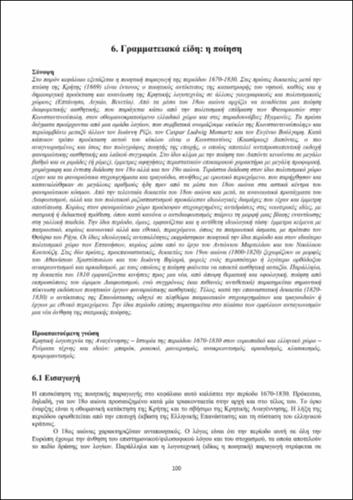| Title Details: | |
|
Literary genres: poetry |
|
| Authors: |
Athini, Anastasia Xourias, Ioannis |
| Reviewer: |
Tampaki, Anna |
| Subject: | HUMANITIES AND ARTS > ARTS AND LETTERS > PHILOLOGY > LITERATURE HUMANITIES AND ARTS > ARTS AND LETTERS > PHILOLOGY |
| Description: | |
| Abstract: |
This chapter examines the poetic production of the period 1670-1830. In the first decades after the fall of Crete (1669), the poetic depiction of the destruction of the island as well as the creative expansion and renewal of Cretan literature in other geographical and cultural regions (Ionian Islands, Aegean, Venice) are evident. From the mid-18th century, a poetry of different aesthetics began to emerge, produced under the cultural influence of the Phanariots in Istanbul, Ottoman-occupied Greece and the Danubian Principalities. The first samples come from a group of scholars, the so-called 'Constantinople circle', including, among others, Ioannis Rizos, Caspar Ludwig Momartz, and Eugenios Voulgaris. Somehow part of this cycle is also Konstantinos (Kaisssarios) Dapontes, the most recognized and perhaps the most prolific poet of the period, who is a representative version of the Phanariot aesthetics and popular writer. The rhymades (or rhymes), narratives in verse of current events with a great deal of oral, manuscript and printed circulation in the 18th and 19th centuries, are largely in the same vein as Daponte's poetry. -Phanariot verses and songs, mainly with erotic content, had also a huge spread in the same cultural environment, produced and consumed in large numbers already before the mid-18th century in the urban centers of the Phanariot world. From the last decade of the 18th century onwards, the renewing projects of the Enlightenment and the political radicalism caused ideological conflicts that were also expressed in verse. Mainly in the Phanariot world, rhymed reactions to modern ideas emerged, with satirical or didactic intentions, in which, generally, counter-Enlightenment takes the form of a violent opposition to French letters. On the other hand, the opposing ideology is also expressed in verse with patriotic, mainly social but also national, content, such as patriotic songs, modelled on the ‘Thourios’ of Rigas. Similar ideological rivalries were poetically expressed at the time in the Ionian Islands, mainly through the work of Antonios Martelaos and Nikolaos Koutouzis. In the first two pre-revolutionary decades of the 19th century (1800-1820), the following figures stand out: Athanasios Christopoulos and Ioannis Vilaras, representing a more or less orthodox Anacreontism and Arcadism, with whom poetry seems to acquire an aesthetic independence. In the 1810s, representatives of the mature Enlightenment turned to a new poetry in terms of theme and style, while simultaneously (and possibly in contrast) there is a considerable increase in the publication of poetic works of the Phanariot aesthetics. Finally, during the revolutionary decade (1820-1830), the eruption of the Revolution led to an abundance of patriotic verse and songs, or works with a national content. The same period also witnessed a new flourishing of satirical poetry in the context of the civil wars.
|
| Linguistic Editors: |
Apostoli, Persia |
| Technical Editors: |
Angelakos, Ioannis |
| Type: |
Chapter |
| Creation Date: | 2015 |
| Item Details: | |
| License: |
http://creativecommons.org/licenses/by-nc-nd/3.0/gr |
| Handle | http://hdl.handle.net/11419/3330 |
| Bibliographic Reference: | Athini, A., & Xourias, I. (2015). Literary genres: poetry [Chapter]. In Athini, A., & Xourias, I. 2015. Modern Greek Literature 1670-1830 [Undergraduate textbook]. Kallipos, Open Academic Editions. https://hdl.handle.net/11419/3330 |
| Language: |
Greek |
| Is Part of: |
Modern Greek Literature 1670-1830 |
| Publication Origin: |
Kallipos, Open Academic Editions |

